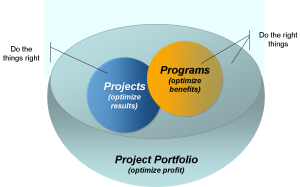German Companies have discovered efficient project management’s value. But what is often less considered yet by the corporate leaders is the right mix of the many single projects.
 In Computerwoche Magazine’s issue of 12. June 2012 the authors Marcus Berger (Director EMM Consulting) and Dr. Thomas Henkelmann (Director Consulting Sevices, TPG The Project Group, München) write about Project Portfolio Management (PPM) and the pitfalls which come up for companies without a structured PPM. The article is in German.
In Computerwoche Magazine’s issue of 12. June 2012 the authors Marcus Berger (Director EMM Consulting) and Dr. Thomas Henkelmann (Director Consulting Sevices, TPG The Project Group, München) write about Project Portfolio Management (PPM) and the pitfalls which come up for companies without a structured PPM. The article is in German.
https://www.computerwoche.de/article/2664316/fallen-im-projekt-management.html
I discovered again how small the Project Management world can be when I had a talk with a friend, a senior program manager these days about an implementation of a Corporate Project Governance to support and ensure strategic alignment of all corporate invests (= projects and programs). Focus topics were
- the elaborated drill down of strategic and tactical corporate goals to “measurable” benefits and connected KPIs, formulated in project objectives,
- development of a corporate Balanced Scorecard for the projects in the pipeline aligned to these corporate goals/ benefits,
- and the definition of adequate processes, including helpful templates, to make this project and program toplogy governance reasonably manageable.
In short: we puzzled our heads over lived program and portfolio management, and resumed (once more) that “usual project management” gets to its limit soon here. Well, it is an own league… ![]()
Learn more about the topic at http://www.pm-professionals.eu/?page_id=57



 Well, you won’t receive an assignment of responsibility for such a mega initiative if you didn’t show some real good performance and results as a PM before. But that’s insufficient in most cases for a programme if you are not familiar with additional PgM methodology and action to take.
Well, you won’t receive an assignment of responsibility for such a mega initiative if you didn’t show some real good performance and results as a PM before. But that’s insufficient in most cases for a programme if you are not familiar with additional PgM methodology and action to take. cost or mistakes’ causes, or even provide the opportunity of new revenues. The IT then is only a means to an end, shall support the professional process with adequate, automated IT processes. The added value doesn’t derive from the technics but of its application in the business.
cost or mistakes’ causes, or even provide the opportunity of new revenues. The IT then is only a means to an end, shall support the professional process with adequate, automated IT processes. The added value doesn’t derive from the technics but of its application in the business. The only means against this dilemma is to sit and talk together again and again – business and IT – about the requirements and how to flesh out the realization. Business is in duty and responsibility that their connotations are picked up and understood correctly, nobody else! And this applies for the developers as well as for those who should use it in the end. This also requires the line department head – not the project manager or the IT – to manage his staff’s expectations.
The only means against this dilemma is to sit and talk together again and again – business and IT – about the requirements and how to flesh out the realization. Business is in duty and responsibility that their connotations are picked up and understood correctly, nobody else! And this applies for the developers as well as for those who should use it in the end. This also requires the line department head – not the project manager or the IT – to manage his staff’s expectations. product, results or capabilities developed in the project.
product, results or capabilities developed in the project. Those basics include:
Those basics include: It’s not astonishing the the report sub-titles this year again “The high Cost of low Performance“, because the statistic rate of projects that miss their schedule, cost or benefit objectives partly or totally, unfortunately has nearly remained at the same high level as last year.
It’s not astonishing the the report sub-titles this year again “The high Cost of low Performance“, because the statistic rate of projects that miss their schedule, cost or benefit objectives partly or totally, unfortunately has nearly remained at the same high level as last year.